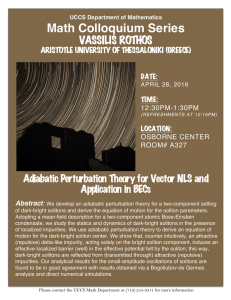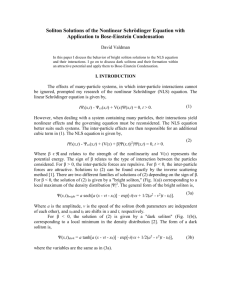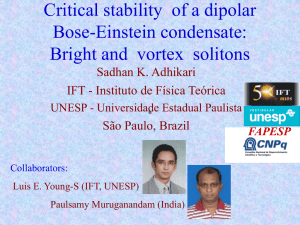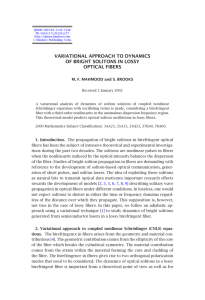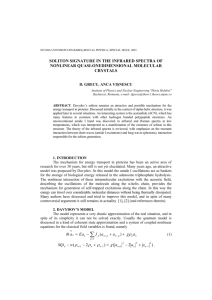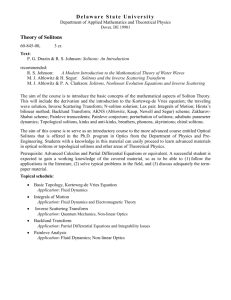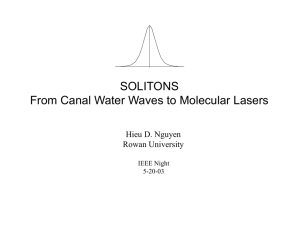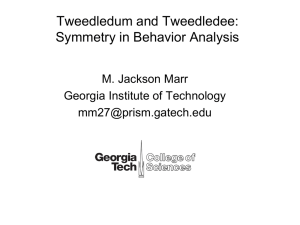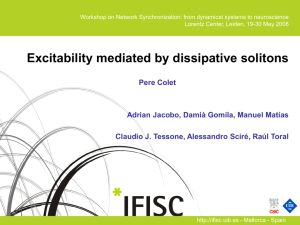Présentation PowerPoint
advertisement
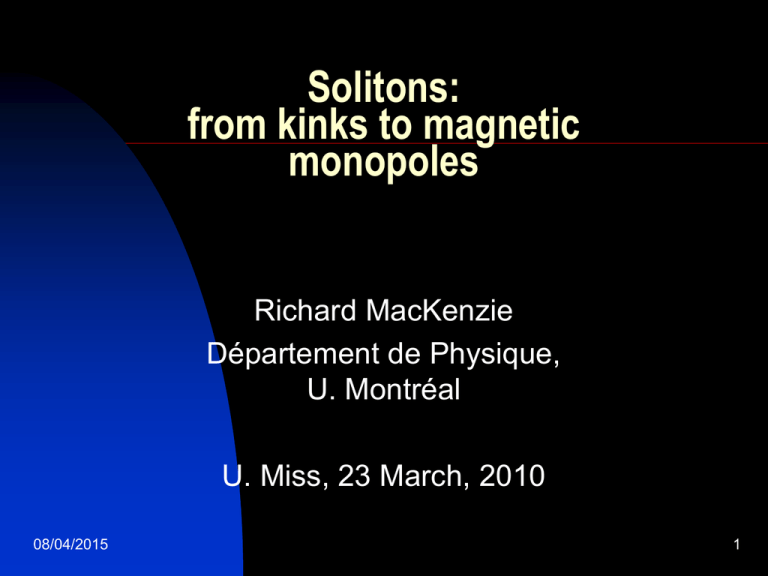
Solitons:
from kinks to magnetic
monopoles
Richard MacKenzie
Département de Physique,
U. Montréal
U. Miss, 23 March, 2010
08/04/2015
1
Outline
1. What is a soliton? Brief history of...
2. Solitons in everyday life
3. Example in 1 dimension : conducting
polymers
4. Topological detour: spontaneous
symmetry breaking
5. Solitons in 2d : superconducting vortices
6. Solitons in 3d : magnetic monopoles
7. A few applications
08/04/2015
2
1. What is a soliton?
Definition: a solution to a set of partial
differential equations which is localized in
space, which is either time dependent or
does not change its form as a function of
time.
or
A localized wave which propagates
without dispersion
08/04/2015
3
History of solitions
First observation: John Scott Russell, 1834
I was observing the motion of a boat which was rapidly drawn along a narrow channel by
a pair of horses, when the boat suddenly stopped—not so the mass of water in the
channel which it had put in motion; it accumulated round the prow of the vessel in a
state of violent agitation, then suddenly leaving it behind, rolled forward with great
velocity, assuming the form of a large solitary elevation, a rounded, smooth and welldefined heap of water, which continued its course along the channel apparently without
change of form or diminution of speed. I followed it on horseback, and overtook it still
rolling on at a rate of some eight or nine miles an hour, preserving its original figure
some thirty feet long and a foot to a foot and a half in height. Its height gradually
diminished, and after a chase of one or two miles I lost it in the windings of the channel.
Such, in the month of August 1834, was my first chance interview with that singular and
beautiful phenomenon which I have called the Wave of Translation.
08/04/2015
4
Soliton on the Scott Russell Aqueduc,
Edinburgh, 12 July, 1995
08/04/2015
5
2. Solitons in everyday life
08/04/2015
6
Bicycle rack solitons
A topological problem encountered in the
parking of bicycles
08/04/2015
7
Bicyce rack: a non-artist’s
misconception:
08/04/2015
8
Formation of a bicycle soliton
08/04/2015
9
Two «ground states»:
08/04/2015
10
Another example
inspired by
everyday life:
08/04/2015
11
3. Solitons in
conducting polymers
08/04/2015
12
Two ground states:
«Peierls Instability»
08/04/2015
13
Mathematical description
Order parameter:
«dimerisation» : φn=(-)nun→φ(x)
where un=displacement of nth C atom
Energy:
E=∑n{k(φn-φn-1)2+V(φn)} →
∫dx{(dφ/dx)2+V(φ)}
08/04/2015
14
Potential energy density:
08/04/2015
15
Soliton («kink»):
|←several C atoms→|
08/04/2015
16
4. A topological detour
Two classes of soliton:
«Nontopological» soliton: owes its existence
to nonlinearities which act against
dispersion (e.g. waves observed by JSR)
«Topological» soliton: owes its existence to a
multiplicity of ground states, giving rise to
topologically non-trivial field configurations
08/04/2015
17
Nontopological vs topological
08/04/2015
18
Multiplicity of ground states: A rare exception?
No! It’s a fact of life with spontaneous symmetry
breaking (SSB)
Symmetry: φ→-φ
08/04/2015
V(-φ)=V(φ)
mais φ= -v→φ=+v
19
Examples of SSB
Ferromagnetism: spontaneous appearance of
magnetization
Broken symmetry: spin rotation SO(3)→SO(2)
Order parameter: magnetization
Space of ground states: S2 (surface of a sphere)
08/04/2015
20
Superconductivity (SC):
Order parameter: wave function of Cooper pairs
(superconducting electrons) – complex scalar field φ
Broken symmetry: rotation of the phase of φ
Space of ground states: S1 (circle)
08/04/2015
21
Electro-weak symmetry in the Standard Model of
particle physics:
Order parameter: Higgs field (two complex
fields (φ1,φ2) )
Broken symmetry: «rotations» of the Higgs
field: SU(2)xU(1) → U(1) (electromag.)
Space of ground states: S3
| φ1|2 + |φ2|2 = v2
08/04/2015
22
Other examples of SSB:
08/04/2015
Grand Unified Theories (GUTs)
Chiral symmetry
Supersymmetry
Family replication symmetry (?)
Lorentz group?
etc
23
5. Solitons in 2d: SC vortex
Order parameter: complex field φ
How to look for solitons: study the space of finiteenergy field configurations
One contribution to the energy of a field
configuration: potential energy
U=∫d2x V(φ(x))
For this to be finite, V(φ)→0 for r→∞ :
|φ|→v -- but phase is arbitrary.
08/04/2015
24
Here are two possibilities:
trivial (vacuum)
08/04/2015
topologically nontrivial
25
Can we make the soliton go away?
Mathematical description: finite energy ↔ map from
spatial infinity to the space of ground states: S1→ S1.
Take-home buzz word: homotopy
π1(S1)=Z
08/04/2015
26
And the gradient energy…?
«It can be shown» that for the soliton,
∫d2x (∂φ)2 →∞ !!!
Is all lost? No! Gauge symmetry comes to the
rescue. If the U(1) symmetry is «gauged»,
∂φ→(∂-ieA)φ
A: vector potential (electromag.)
For φ in the form of a soliton, we can find an A with
which the gradient energy is finite.
08/04/2015
27
Unexpected bonus: soliton contains
magnetic flux
08/04/2015
28
Abrikosov lattice: Type II superconductor in a sufficiently
strong magnetic field: field penetrates by forming a
lattice of vortices (Abrikosov 1957; Nobel Prize in
Physics, 2003!!!)
08/04/2015
29
6. Solitons in 3d: magnetic
monopoles
Toy model :
triplet of real fields (φ1,φ2,φ3)
symmetric under rotations SO(3)
SSB : SO(3)→SO(2)~U(1)
Space of ground states : S2
symmetry gauged : non-abelian gauge
theory (unbroken symmetry: U(1) e.m.)
08/04/2015
30
Existence of solitons (3d) follows from the
topological result : π2(S2)=Z
Soliton:
08/04/2015
31
As with the vortex, the gradient energy diverges.
Again, this can be remedied via the (nonabelian) gauge field.
This time, the gauge field describes a magnetic
flux coming from the soliton: far from it, the
magnetic field is a Coulomb field; the soliton is
a magnetic monopole (« ’t Hooft-Polyakov
monopole »).
Does this occur in the Standard Model? No...
but any GUT (or model which reduces to a
GUT) has magnetic monopoles.
08/04/2015
32
7. A few «applications»
(a) Quantization of electric charge.
Observational fact : The charge of every particle
we know is a multiple of e (or e/3 with quarks)
Question : WHY?
08/04/2015
33
Dirac (1931) : If a magnetic monopole existed, the
quantum mechanics of a charged particle in the
presence of the monopole does not make sense
unless the electric charge is quantized. (Thus,
the fact that electric charge does seem to be
quantized is suggestive of the existence of
magnetic monopoles!)
Modern context : In field theory, charge need not
be quantized... but in GUTs,
(i) electric charge is quantized;
(ii) monopoles do exist.
08/04/2015
34
(b) Cosmology, phase transitions,
topological defects
Following the Big Bang, the Universe expanded
and cooled, causing (via SSB) phase
transitions : eg
SU(5) → SU(3)xSU(2)xU(1) → SU(3)xU(1)
08/04/2015
35
Depending on the details of the SSB, many
possibilities exist :
08/04/2015
36
Subsequent cooling : topological defects become
regions of overdensity → seeds for the
formation of structure in the Universe
08/04/2015
37
(c) Large extra dimensions – where are they?
If the Universe is of dimension > 3+1, the extra
dimensions could be small (Kaluza-Klein
models, superstrings) or large (D-branes,
Randall-Sundrum, etc)
One way to reconcile the existence of large
extra dimensions with our observed 3+1d
Universe is if we live in the core of a 3dimensional topological defect.
08/04/2015
38
Toy model:
Field giving rise to solitons : φ
Fields of ordinary matter : ψ,ξ,…
08/04/2015
39
8. What I said
08/04/2015
Pay attention to where you park your
bicycle!
Topological solitons ; importance of
spontaneous symmetry breaking
examples in 1d (polymers), 2d
(vortices), 3d (magnetic monopoles)
a couple of «applications»
40
Thank you!
08/04/2015
41
